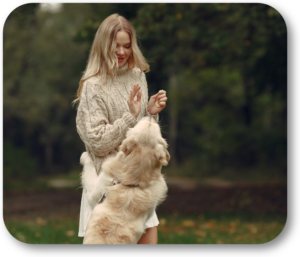I was in Decantur last Monday working with a new Home Dog Training client and her Bernese Mountain Dog named George. George had just turned two and a half and had grown from a cute and cuddly puppy into a “very healthy” young dog weighing over 100 pounds. We worked through the standard obedience commands including come, sit, stay, walk, etc.

We also worked on some of his behavioral issues such as stealing the kids’ toys, barking, etc. Although it didn’t happen all the time, one of the biggest issues she had with George was his jumping. “My dog is normally a good dog, but I can’t keep him from jumping on my guests whenever they come to visit. It was cute when he was a puppy, but now he is over 100 lbs. What is going on here?”
I told her that George was a great dog and that by the end of our session, his sporadic inappropriate jumping will be a “thing of the past”. I went on to state that jumping is the number one “annoying problem” that, unfortunately, most dog owners bring on themselves. Puppies are so much fun when they are new and little. They are so full of life and just wanting affection all day long.
You allow them to jump on you and you give them hugs, run around the house with them, play with them every time they bring you toys, pet them when they put their cute, wet noses in your hand, and a whole lot of other “puppy things”.
The issue is that you are continually teaching and socializing them to do things you eventually don’t want to occur. You are continuously allowing them to jump, chase, and demand attention. Dogs learn through a very black and white method. If you teach your dog to jump, he will assume that it is OK to jump on everybody all the time. If you teach him to demand attention, he can demand attention from everybody all the time.
We tell our clients that as they interact with their puppies or dogs, they need to recognize that whatever they ask them to do is universal. From their dog’s perspective, whatever they are allowed to do or whatever they are taught; can be done all the time, no matter what.
“It is OK if my dog jumps on me, but not my guests” is something that our client can understand, but George, her dog will not understand. All her dog can understand is “I can jump”. We tell our clients that they need to consider the totality of an action or command. Whatever they tell their dog to do must be universal.
The bottom line is to think of your rules, or what you want your dog to do through his eyes. Examples of what your rules might be are:
- No jumping.
- Off the furniture.
- Not in baby’s room.
- No counter surfing…
I often like to put this in a human, real-world example. Think of a Stop Sign. The sign says STOP. We must always stop at the sign, no matter what. The rule for the sign is simple; STOP. That is the same concept and outcome we must use when generating our rules for our dog.
Once we begin interacting with our dog in a clear, repetitive, and concise manner, they will have the ability to easily obey us. Once my client began to constantly correct and direct George not to jump, period, he stopped jumping. It wasn’t that he was a bad dog, he just needed to be taught in a manner that he understood.
Please call Robin or me at (770) 718-7704 if you need any dog training help. We are blessed to have been your local dog training professionals for over seventeen years. We have trained over 5,000 great dogs and loving families and are ready to help you.

Follow Us!